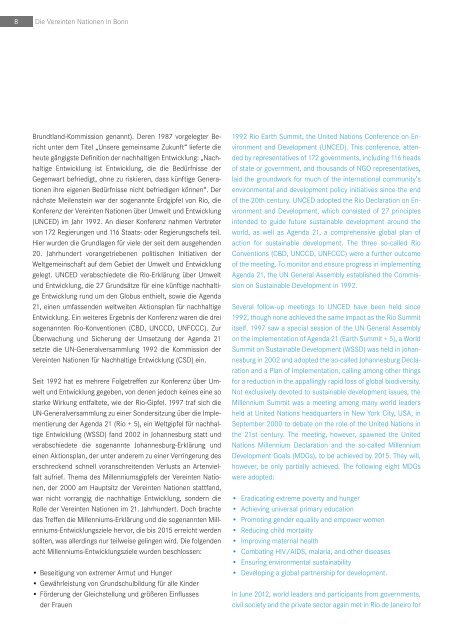Die Vereinten Nationen in Bonn
UN BONN - Die Vereinten Nationen in Bonn; Autor: Rüdiger Strempel
UN BONN - Die Vereinten Nationen in Bonn;
Autor: Rüdiger Strempel
Sie wollen auch ein ePaper? Erhöhen Sie die Reichweite Ihrer Titel.
YUMPU macht aus Druck-PDFs automatisch weboptimierte ePaper, die Google liebt.
8 <strong>Die</strong> <strong>Vere<strong>in</strong>ten</strong> <strong>Nationen</strong> <strong>in</strong> <strong>Bonn</strong><br />
Brundtland-Kommission genannt). Deren 1987 vorgelegter Bericht<br />
unter dem Titel „Unsere geme<strong>in</strong>same Zukunft“ lieferte die<br />
heute gängigste Def<strong>in</strong>ition der nachhaltigen Entwicklung: „Nachhaltige<br />
Entwicklung ist Entwicklung, die die Bedürfnisse der<br />
Gegenwart befriedigt, ohne zu riskieren, dass künftige Generationen<br />
ihre eigenen Bedürfnisse nicht befriedigen können“. Der<br />
nächste Meilenste<strong>in</strong> war der sogenannte Erdgipfel von Rio, die<br />
Konferenz der <strong>Vere<strong>in</strong>ten</strong> <strong>Nationen</strong> über Umwelt und Entwicklung<br />
(UNCED) im Jahr 1992. An dieser Konferenz nahmen Vertreter<br />
von 172 Regierungen und 116 Staats- oder Regierungschefs teil.<br />
Hier wurden die Grundlagen für viele der seit dem ausgehenden<br />
20. Jahrhundert vorangetriebenen politischen Initiativen der<br />
Weltgeme<strong>in</strong>schaft auf dem Gebiet der Umwelt und Entwicklung<br />
gelegt. UNCED verabschiedete die Rio-Erklärung über Umwelt<br />
und Entwicklung, die 27 Grundsätze für e<strong>in</strong>e künftige nachhaltige<br />
Entwicklung rund um den Globus enthielt, sowie die Agenda<br />
21, e<strong>in</strong>en umfassenden weltweiten Aktionsplan für nachhaltige<br />
Entwicklung. E<strong>in</strong> weiteres Ergebnis der Konferenz waren die drei<br />
sogenannten Rio-Konventionen (CBD, UNCCD, UNFCCC). Zur<br />
Überwachung und Sicherung der Umsetzung der Agenda 21<br />
setzte die UN-Generalversammlung 1992 die Kommission der<br />
<strong>Vere<strong>in</strong>ten</strong> <strong>Nationen</strong> für Nachhaltige Entwicklung (CSD) e<strong>in</strong>.<br />
Seit 1992 hat es mehrere Folgetreffen zur Konferenz über Umwelt<br />
und Entwicklung gegeben, von denen jedoch ke<strong>in</strong>es e<strong>in</strong>e so<br />
starke Wirkung entfaltete, wie der Rio-Gipfel. 1997 traf sich die<br />
UN-Generalversammlung zu e<strong>in</strong>er Sondersitzung über die Implementierung<br />
der Agenda 21 (Rio + 5), e<strong>in</strong> Weltgipfel für nachhaltige<br />
Entwicklung (WSSD) fand 2002 <strong>in</strong> Johannesburg statt und<br />
verabschiedete die sogenannte Johannesburg-Erklärung und<br />
e<strong>in</strong>en Aktionsplan, der unter anderem zu e<strong>in</strong>er Verr<strong>in</strong>gerung des<br />
erschreckend schnell voranschreitenden Verlusts an Artenvielfalt<br />
aufrief. Thema des Millenniumsgipfels der <strong>Vere<strong>in</strong>ten</strong> <strong>Nationen</strong>,<br />
der 2000 am Hauptsitz der <strong>Vere<strong>in</strong>ten</strong> <strong>Nationen</strong> stattfand,<br />
war nicht vorrangig die nachhaltige Entwicklung, sondern die<br />
Rolle der <strong>Vere<strong>in</strong>ten</strong> <strong>Nationen</strong> im 21. Jahrhundert. Doch brachte<br />
das Treffen die Millenniums-Erklärung und die sogenannten Millenniums-Entwicklungsziele<br />
hervor, die bis 2015 erreicht werden<br />
sollten, was allerd<strong>in</strong>gs nur teilweise gel<strong>in</strong>gen wird. <strong>Die</strong> folgenden<br />
acht Millenniums-Entwicklungsziele wurden beschlossen:<br />
• Beseitigung von extremer Armut und Hunger<br />
• Gewährleistung von Grundschulbildung für alle K<strong>in</strong>der<br />
• Förderung der Gleichstellung und größeren E<strong>in</strong>flusses<br />
der Frauen<br />
1992 Rio Earth Summit, the United Nations Conference on Environment<br />
and Development (UNCED). This conference, attended<br />
by representatives of 172 governments, <strong>in</strong>clud<strong>in</strong>g 116 heads<br />
of state or government, and thousands of NGO representatives,<br />
laid the groundwork for much of the <strong>in</strong>ternational community’s<br />
environmental and development policy <strong>in</strong>itiatives s<strong>in</strong>ce the end<br />
of the 20th century. UNCED adopted the Rio Declaration on Environment<br />
and Development, which consisted of 27 pr<strong>in</strong>ciples<br />
<strong>in</strong>tended to guide future susta<strong>in</strong>able development around the<br />
world, as well as Agenda 21, a comprehensive global plan of<br />
action for susta<strong>in</strong>able development. The three so-called Rio<br />
Conventions (CBD, UNCCD, UNFCCC) were a further outcome<br />
of the meet<strong>in</strong>g. To monitor and ensure progress <strong>in</strong> implement<strong>in</strong>g<br />
Agenda 21, the UN General Assembly established the Commission<br />
on Susta<strong>in</strong>able Development <strong>in</strong> 1992.<br />
Several follow-up meet<strong>in</strong>gs to UNCED have been held s<strong>in</strong>ce<br />
1992, though none achieved the same impact as the Rio Summit<br />
itself. 1997 saw a special session of the UN General Assembly<br />
on the implementation of Agenda 21 (Earth Summit + 5), a World<br />
Summit on Susta<strong>in</strong>able Development (WSSD) was held <strong>in</strong> Johannesburg<br />
<strong>in</strong> 2002 and adopted the so-called Johannesburg Declaration<br />
and a Plan of Implementation, call<strong>in</strong>g among other th<strong>in</strong>gs<br />
for a reduction <strong>in</strong> the appall<strong>in</strong>gly rapid loss of global biodiversity.<br />
Not exclusively devoted to susta<strong>in</strong>able development issues, the<br />
Millennium Summit was a meet<strong>in</strong>g among many world leaders<br />
held at United Nations headquarters <strong>in</strong> New York City, USA, <strong>in</strong><br />
September 2000 to debate on the role of the United Nations <strong>in</strong><br />
the 21st century. The meet<strong>in</strong>g, however, spawned the United<br />
Nations Millennium Declaration and the so-called Millennium<br />
Development Goals (MDGs), to be achieved by 2015. They will,<br />
however, be only partially achieved. The follow<strong>in</strong>g eight MDGs<br />
were adopted:<br />
• Eradicat<strong>in</strong>g extreme poverty and hunger<br />
• Achiev<strong>in</strong>g universal primary education<br />
• Promot<strong>in</strong>g gender equality and empower women<br />
• Reduc<strong>in</strong>g child mortality<br />
• Improv<strong>in</strong>g maternal health<br />
• Combat<strong>in</strong>g HIV/AIDS, malaria, and other diseases<br />
• Ensur<strong>in</strong>g environmental susta<strong>in</strong>ability<br />
• Develop<strong>in</strong>g a global partnership for development.<br />
In June 2012, world leaders and participants from governments,<br />
civil society and the private sector aga<strong>in</strong> met <strong>in</strong> Rio de Janeiro for









